Analysis of Weather-Related Growth Differences in Winter Wheat in a Three-Year Field Trial in North-East Germany
Abstract
:1. Introduction
- Which differences in growth are evident depending on the weather?
- Are there variety-specific differences in drought stress resistance and yield?
- Does irrigation allow a constant grain yield over all years?
- Which biometric parameters are relevant for determining the grain yield?
- Is irrigation economical?
2. Materials and Methods
2.1. Materials
2.1.1. Selected Winter Wheat Varieties
- Kerubino (E): medium cultivation significance with decreasing tendency
- Opal (A): medium cultivation significance, stable over time
- Edgar (B): no cultivation significance
2.1.2. Experimental Site and Setup
2.2. Methods
2.2.1. Data Collection in the Field
2.2.2. Agrometeorological Soil-Water Balance Model METVER
2.2.3. Data Evaluation
3. Results
3.1. Agrometeorological Situation in the Trial Years
3.2. Results of Field Trial
4. Discussion
4.1. Weather-Related Differences in Growth of the Winter Wheat Varieties Examined
4.2. Consistent Yields of the Winter Wheat Varieties through Irrigation
4.3. Variety-Specific Differences with Regard to Drought Stress Resistance and Yield
4.4. Determination of Grain Yield on the Basis of the Biometric Parameters Collected
4.5. Irrigation Efficiency
5. Conclusions
Author Contributions
Funding
Institutional Review Board Statement
Informed Consent Statement
Acknowledgments
Conflicts of Interest
References
- Iwańska, M.; Paderewski, J.; Stępień, M.; Rodrigues, P.C. Adaptation of Winter Wheat Cultivars to Different Environments: A Case Study in Poland. Agron. J. 2020, 10, 632. [Google Scholar] [CrossRef]
- Du, X.; Li, Q.; Wang, H.; Liu, J.; Zhao, L.; Zhang, H.; Wang, N. A simple assessment approach for winter wheat loss risk impacted by water stress. Geocarto Int. 2019, 34, 473–489. [Google Scholar] [CrossRef]
- Schittenhelm, S.; Kottmann, L.; Kraft, M.; Matschiner, K.; Langkamp-Wedde, T. Agronomic performance of winter wheat grown under highly divergent soil moisture conditions in rainfed and water-managed environments. J. Agron. Crop. Sci. 2019, 205, 283–294. [Google Scholar] [CrossRef]
- Mäkinen, H.; Kaseva, J.; Trnka, M.; Balek, J.; Kersebaum, K.C.; Nendel, C.; Gobin, A.; Olesen, J.E.; Bindi, M.; Ferrise, R.; et al. Sensitivity of European wheat to extreme weather. Field Crop. Res. 2018, 222, 209–217. [Google Scholar] [CrossRef]
- Schaller, M.; Weigel, H.-J. Analyse des Sachstands zu Auswirkungen von Klimaveränderungen auf die deutsche Landwirtschaft und Maßnahmen zur Anpassung. FAL Agric. Res. 2007, 316, 39–48. [Google Scholar]
- DESTATIS-Statistisches Bundesamt. Anbaufläche von Winterweizen im Jahr 2020 um 7% Gesunken. Available online: https://www.destatis.de/DE/Presse/Pressemitteilungen/2020/05/PD20_168_412.html (accessed on 3 November 2020).
- Lüttger, A.B.; Feike, T. Development of heat and drought related extreme weather events and their effect on winter wheat yields in Germany. Theor. Appl. Climatol. 2018, 132, 15–29. [Google Scholar] [CrossRef]
- Balla, K.; Karsai, I.; Bónis, P.; Kiss, T.; Berki, Z.; Horváth, Á.; Mayer, M.; Bencze, S.; Veisz, O. Heat stress responses in a large set of winter wheat cultivars (Triticum aestivum L.) depend on the timing and duration of stress. PLoS ONE 2019, 14, e0222639. [Google Scholar] [CrossRef] [PubMed]
- Bönecke, E.; Breitsameter, L.; Brüggemann, N.; Chen, T.W.; Feike, T.; Kage, H.; Kersebaum, K.C.; Piepho, H.P.; Stützel, H. Decoupling of impact factors reveals the response of German winter wheat yields to climatic changes. Glob. Chang. Biol. 2020, 26, 3601–3626. [Google Scholar] [CrossRef]
- I.G.Pflanzenzucht GmbH. Winterweizen: Sortenblatt für Kerubino. Available online: https://ig-pflanzenzucht.de/sorte/kerubino/ (accessed on 3 August 2020).
- Bundessortenamt. Beschreibende Sortenliste: Getreide, Mais, Öl- und Faserpflanzen, Leguminosen, Rüben, Zwischenfrüchte. Available online: https://www.bundessortenamt.de/bsa/media/Files/BSL/bsl_getreide_2019.pdf (accessed on 15 September 2020).
- KWS. Neutraler Sortenvergleich-Winterweizen. Available online: https://www.kws.com/de/de/beratung/saatgut/sortenwahl/neutraler-sortenvergleich/ (accessed on 2 November 2020).
- Eckelmann, W.; Sponagel, H.; Grottenthaler, W.; Hartmann, K.J.; Hartwich, R.; Janetzko, P.; Joisten, H.; Kühn, D.; Sabel, K.J.; Traidl, R. Bodenkundliche Kartieranleitung (KA5), 2nd ed.; Dynamax Inc.: Hannover, Germany, 2005; p. 344. [Google Scholar]
- Dynamax Inc. Theta Probe Type ML2x. Available online: https://d3pcsg2wjq9izr.cloudfront.net/files/23948/download/11438/ml2x.pdf (accessed on 2 November 2020).
- LI-COR. Soil Moisture Probe ML2x. Available online: https://www.licor.com/documents/md85p0ueyhvnqfm5r93n (accessed on 2 November 2020).
- Müller, J.; Müller, G. Berechnung der Verdunstung landwirtschaftlicher Produktionsgebiete. Beschreibung des zur Bestimmung der aktuellen Evapotranspiration von Kulturpflanzenbeständen erarbeiteten Modells. Z. für Meteorol. 1988, 38, 332–337. [Google Scholar]
- Knoor, D.; Weise, C. Blattflächenindex und Bedeckungsgrad. Available online: http://www.terradew.uni-jena.de/sites/lai.html (accessed on 3 July 2020).
- Konica Minolta. Spezifikation Chlorophyll Meter SPAD-502 Plus. Available online: https://www5.konicaminolta.eu/en/measuring-instruments/products/colour-measurement/chlorophyll-meter/spad-502plus/specifications.html (accessed on 2 November 2020).
- Witzenberger, A.; Hack, H.; van den Boom, T. Erläuterungen zum BBCH-Dezimal-Code für die Entwicklungsstadien des Getreides—Mit Abbildungen. Gesunde Pflanz. 1989, 41, 384–388. [Google Scholar]
- Lancashire, P.D.; Bleiholder, H.; Langeluddecke, P.; Stauss, R.; van den Boom, T.; Weber, E.; Witzen-Berger, A. An uniform decimal code for growth stages of crops and weeds. Ann. Appl. Biol. 1991, 119, 561–601. [Google Scholar] [CrossRef]
- Dynamax Inc. Sunscan Probe. Available online: https://www.delta-t.co.uk/product/sunscan (accessed on 2 November 2020).
- Richter, D. Verfahrenshinweiß zur Korrektur von verdichteten Werten der Niederschlagshöhe. Arb. Gutacht. des Meteorol. Dienstes der DDR 1981, 3, 1–3. [Google Scholar]
- Müller, J.; Jörn, P.; Thiere, J. Erarbeitung einer Karte der pflanzennutzbaren Feldkapazität für die neuen Bundesländer. Mitteilgn. Dtsch. Bodenkundl. Gesellsch. 1995, 76, 1149–1153. [Google Scholar]
- Bach, S. Anpassung des Agrarmeteorologischen Wasserhaushaltsmodells METVER an Aktuelle Erfordernisse vor dem Hintergrund Sich Wandelnder Klimatischer Randbedingungen und Pflanzenbaulicher Gegebenheiten; Masterarbeit University Leipzig: Leipzig, Germany, 2011. [Google Scholar]
- StatsDirect Limited. Unpaired (Two Sample) t Test. Available online: https://statsdirect.com/help/content/parametric_methods/unpaired_t.htm (accessed on 19 November 2020).
- LaMorte, W.W.; The Multiple Linear Regression Equation. Boston University School of Public Health. Available online: https://sphweb.bumc.bu.edu/otlt/MPH-Modules/BS/BS704-EP713_MultivariableMethods/BS704-EP713_MultivariableMethods2.html (accessed on 19 November 2020).
- KTBL, e.V. Faustzahlen für die Landwirtschaft; KTBL e.V.: Darmstadt, Germany, 2009; pp. 157–158. [Google Scholar]
- Böttcher, F.; Schmidt, M.; Der Boden aus Sicht der Agrarmeteorologie-Bodentemperatur und -Wasserhaushalt. Bundesministerium für Ernährung und Landwirtschaft. Available online: https://www.bmel.de/DE/themen/landwirtschaft/pflanzenbau/bodenschutz/agrarmeteorologie.html (accessed on 20 July 2020).
- Deutscher Wetterdienst. Deutschlandwetter im Winter 2014/15: Sehr Mild, Bei Ausgeglichenem Niederschlag und Etwas Wenig Sonne. Available online: https://www.dwd.de/DE/presse/pressemitteilungen/DE/2015/20150227_Deutschlandwetter_Winter2014_2015.pdf?__blob=publicationFile&v=3 (accessed on 16 October 2020).
- Deutscher Wetterdienst. Deutschlandwetter im Sommer 2015: Heiß, Trocken und Sonnig-ein Sommer mit Vielen Rekorden. Available online: https://www.dwd.de/DE/presse/pressemitteilungen/DE/2015/20150828_deutschlandwetter_sommer_2015.pdf?__blob=publicationFile&v=3 (accessed on 16 October 2020).
- KSB. Klimastatusbericht 2016. Available online: https://www.dwd.de/DE/leistungen/klimastatusbericht/publikationen/ksb_2016.html (accessed on 28 September 2020).
- KSB. Klimastatusbericht 2017. Available online: https://www.dwd.de/DE/leistungen/klimastatusbericht/publikationen/ksb_2017.html (accessed on 15 September 2020).
- Zhang, H.; Oweis, T.; Garabet, S.; Pala, M. Water-use efficiency and transpiration efficiency of wheat under rain-fed conditions and supplemental irrigation in a Mediterranean-type environment. Plant Soil 1998, 201, 295–305. [Google Scholar] [CrossRef]
- Zwidofhelangani, A. Water Stress Effects on Growth, Yield and Quality of Wheat (Triticum aestivum L.). Ph.D. Thesis, University of Pretoria, Pretoria, South Africa, 2013. Available online: https://repository.up.ac.za/xmlui/bitstream/handle/2263/24146/dissertation.pdf?sequence=1&isAllowed=y (accessed on 7 March 2021).
- Blum, A. Crop response to drought and the interpretation of adaptation. Plant Growth Regul. 1996, 135–248. [Google Scholar] [CrossRef]
- Davies, W.J. Responses of plant growth and functioning to changes in water supply in a changing climate, Morison, J.I.L., Morecroft, M.D. (pbl.). Plant Growth Clim. Chang. 2006, 96–117. [Google Scholar] [CrossRef]
- Hlaváčová, M.; Klem, K.; Rapantová, B.; Novotná, K.; Urban, O.; Hlavinka, P.; Smutná, P.; Horáková, V.; Škarpa, P.; Pohanková, E.; et al. Interactive effects of high temperature and drought stress during stem elongation, anthesis and early grain filling on the yield formation and photosynthesis of winter wheat. Field Crop. Res. 2018, 221, 182–195. [Google Scholar] [CrossRef]
- Ganji Arjenaki, F.; Jabbari, A.; Morshedi, A. Evaluation of Drought Stress on Relative Water Content, Chlorophyll Content and Mineral Elements of Wheat (Triticum aestivum L.) Varieties. Int. J. Agric. Crop. Sci. 2011, 4, 726–729. Available online: https://www.researchgate.net/publication/267425480_Evaluation_of_Drought_Stress_on_Relative_Water_Content_Chlorophyll_Content_and_Mineral_Elements_of_Wheat_Triticum_aestivum_L_Varieties (accessed on 12 July 2021).
- Jatoi, W.A.; Baloch, M.J.; Kumbhar, M.B.; Khan, N.U.; Kerio, M.I. Effect of water stress on physiological and yield parameters at anthesis stages in elite spring wheat cultivars. Sarhad J. Agric. 2011, 27, 59–65. [Google Scholar]
- Abdullah, F.; Hareri, F.; Naaesan, M.; Adel Amar, M.; Zuher Kanbar, O. Effect of Drought on Different Physiological Characters and Yield Component in Different Varieties of Syrian Durum Wheat. J. Agric. Sci. 2011, 3, 127–133. Available online: https://www.researchgate.net/publication/342131357_Physiological_Performance_Of_Different_Durum_Wheat_Varieties_Grown_Under_Rainfed_Condition (accessed on 3 August 2021).
- Farooq, M.; Wahid, A.; Kobayashi, N.; Fujita, D.; Basra, S. Plant drought stress: Effects, mechanisms and management. Agron. Sustain. Dev. 2008, 29, 185–212. [Google Scholar] [CrossRef] [Green Version]
- Amt für Statistik Berlin-Brandenburg. Ernteberichterstattung über Feldfrüchte und Grünland im Land Brandenburg 2015. Available online: https://www.statistik-berlin-brandenburg.de/publikationen/stat_berichte/2016/SB_C02-02-00_2015j01_BB.pdf (accessed on 1 November 2020).
- Amt für Statistik Berlin-Brandenburg. Ernteberichterstattung über Feldfrüchte und Grünland im Land Brandenburg 2017. Available online: https://www.statistik-berlin-brandenburg.de/publikationen/stat_berichte/2018/SB_C02-02-00_2017j01_BB.pdf (accessed on 1 November 2020).
- Bogale, A.; Tesfaye, K.; Geleto, T. Morphological and physiological attributes associated to drought tolerance of Ethiopian durum wheat genotypes under water deficit condition. J. Biodivers. Agric. Sci. 2011, 1, 22–36. Available online: https://www.researchgate.net/publication/280831210_Morphological_and_physiological_attributes_associated_to_drought_tolerance_of_Ethiopian_durum_wheat_genotypes_under_water_deficit (accessed on 17 July 2021).
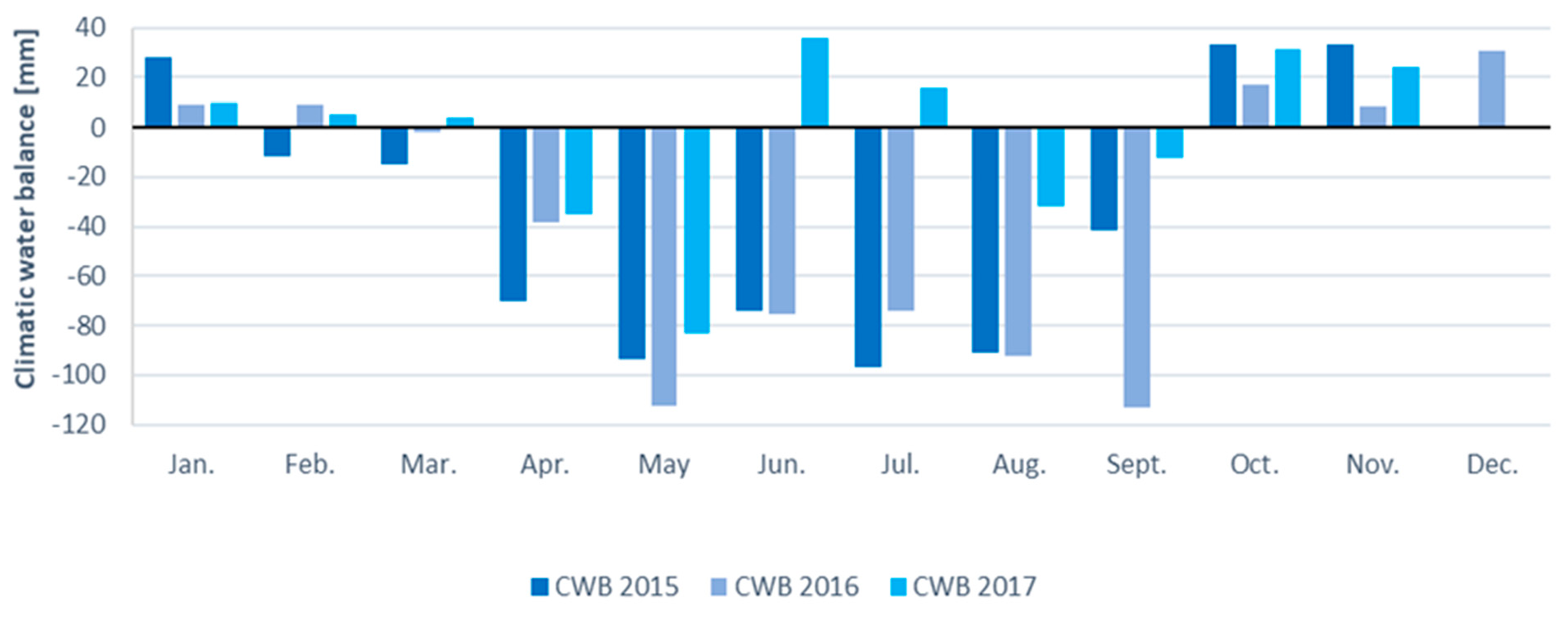
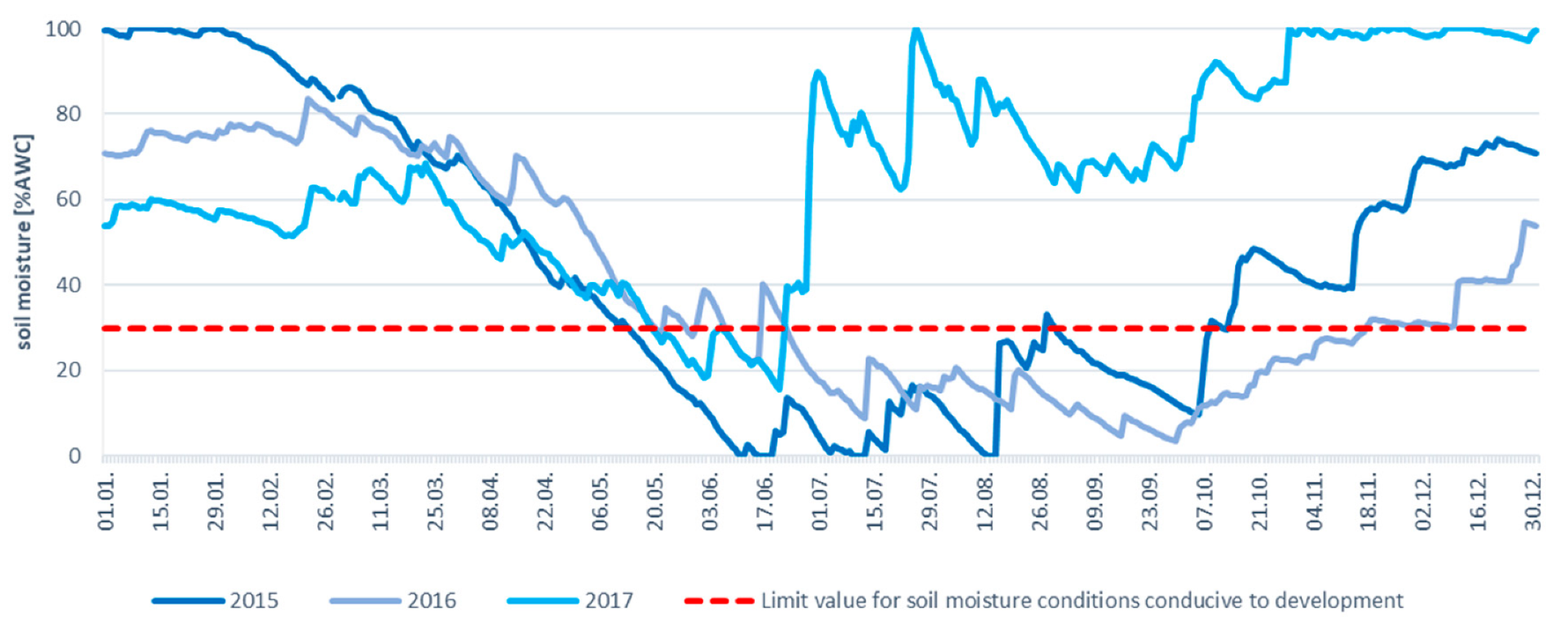
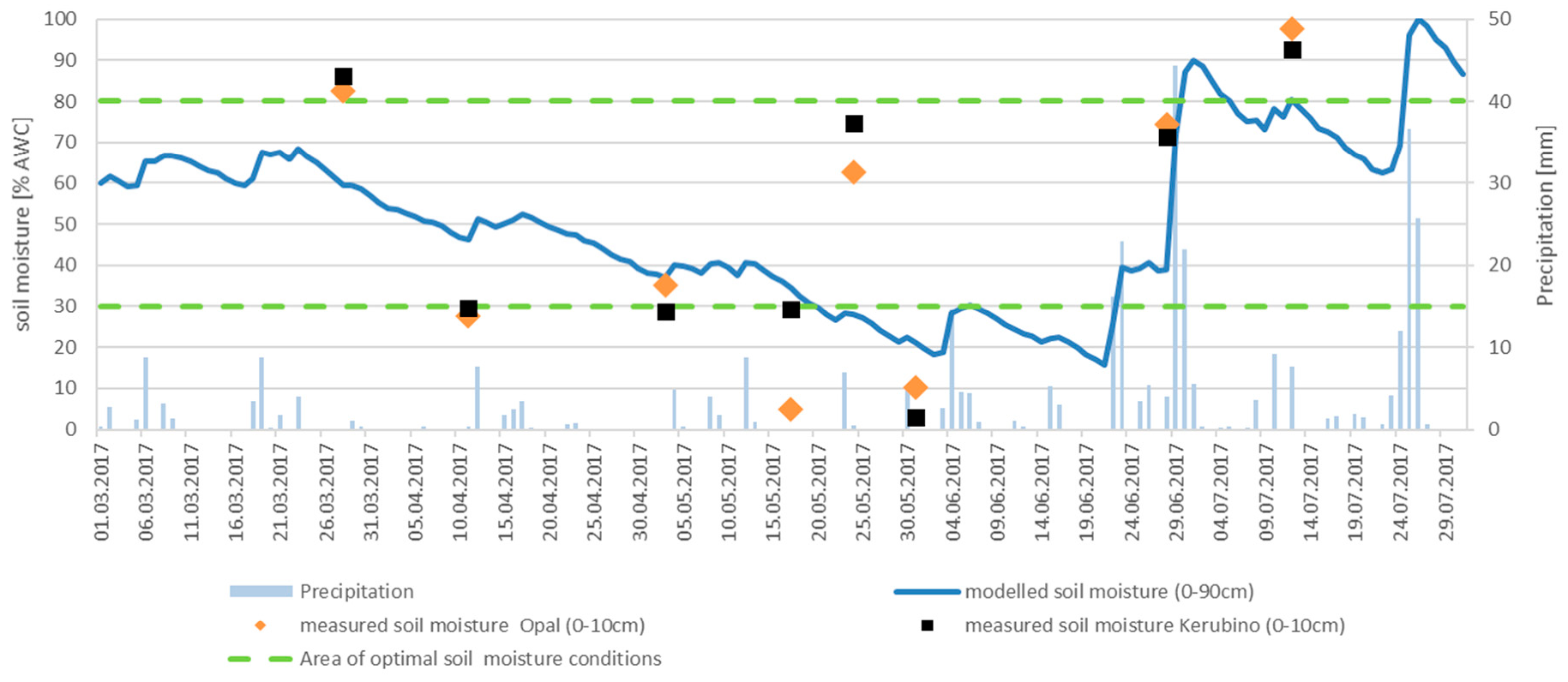

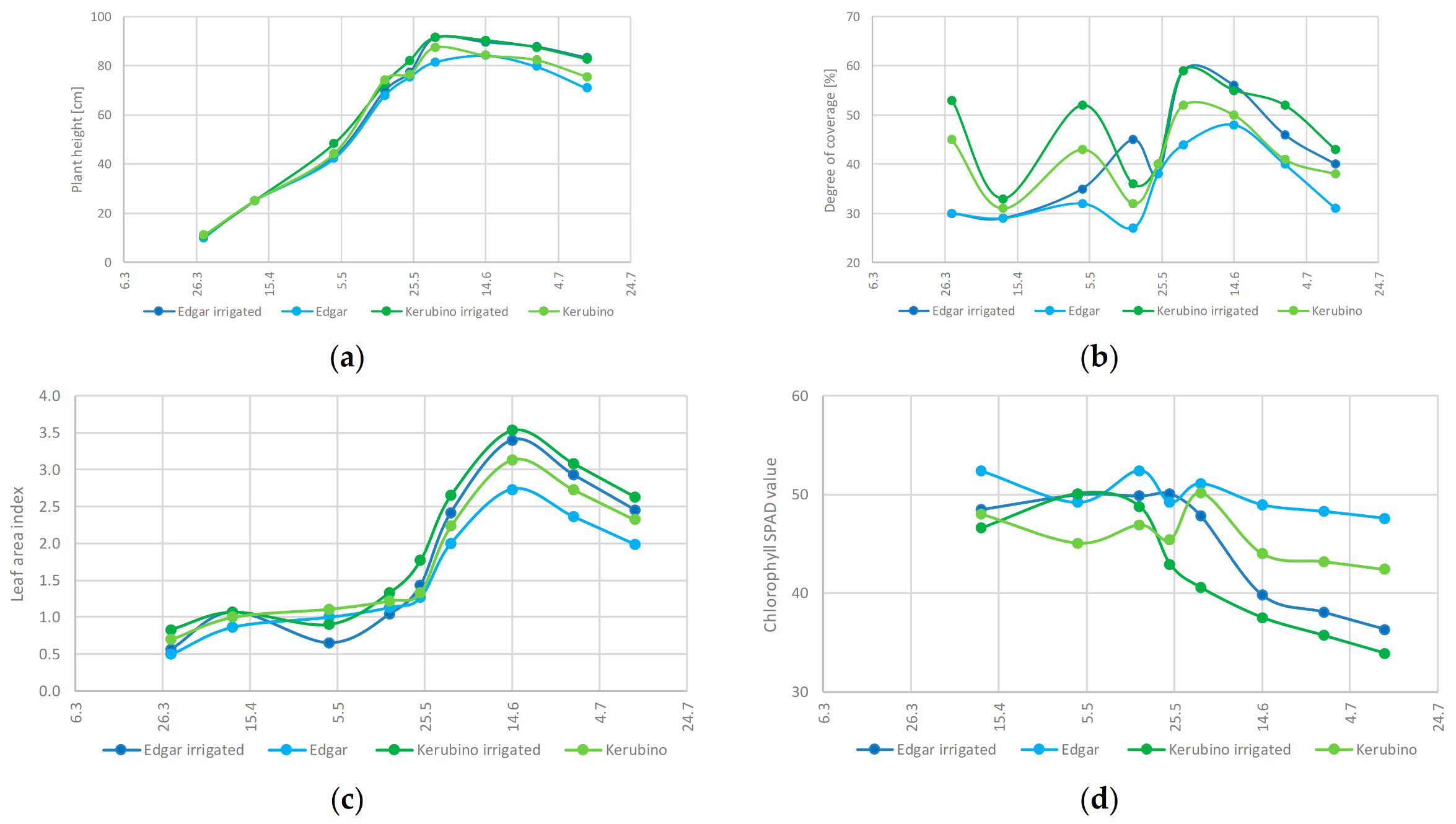
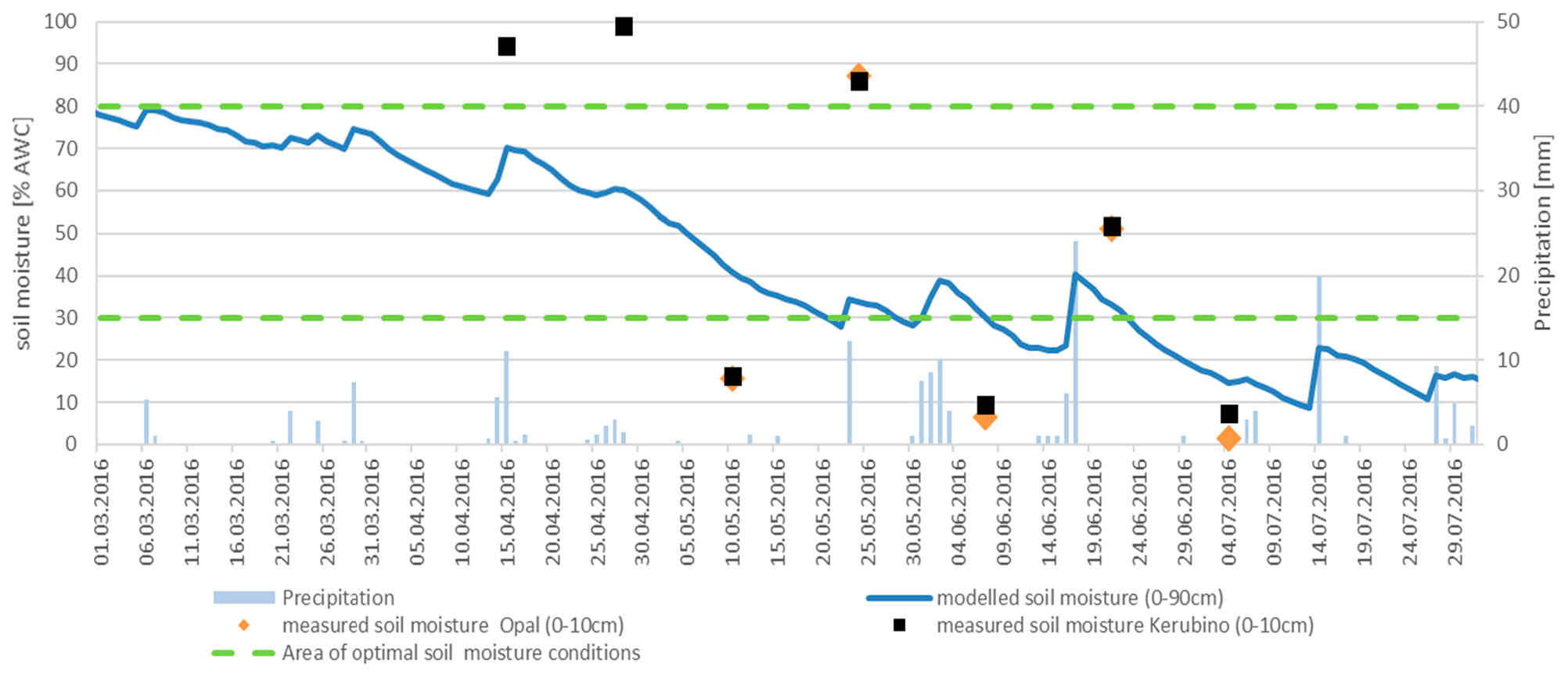
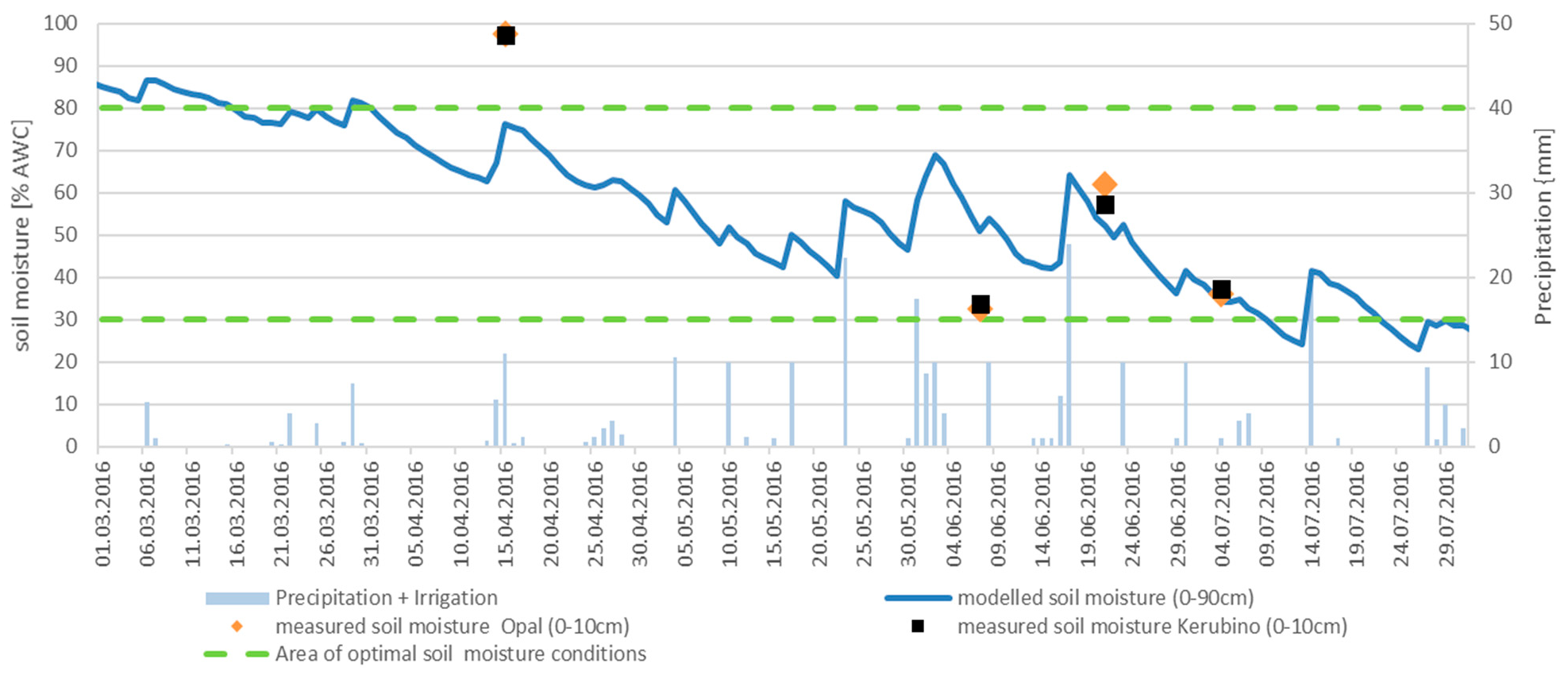
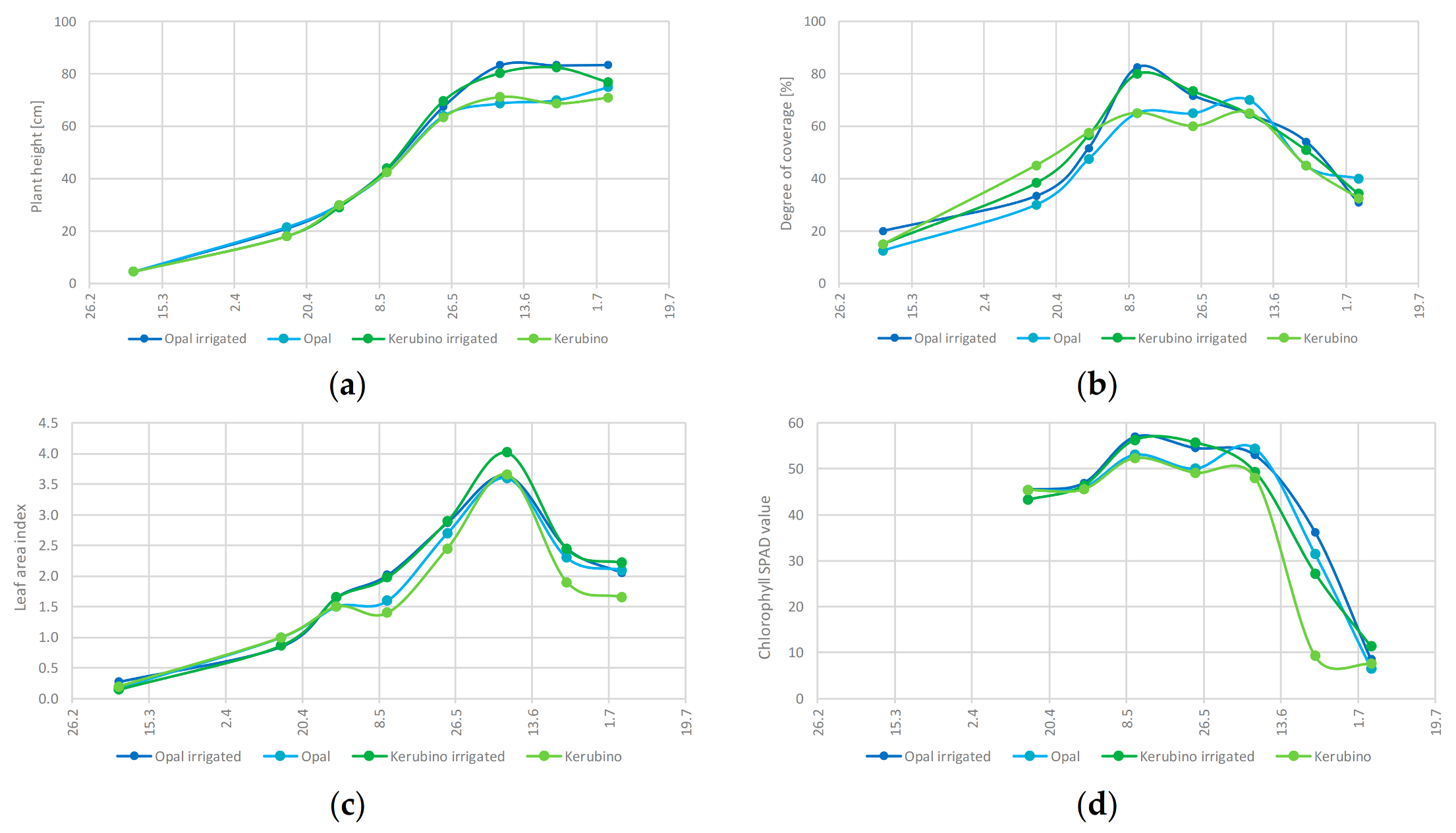
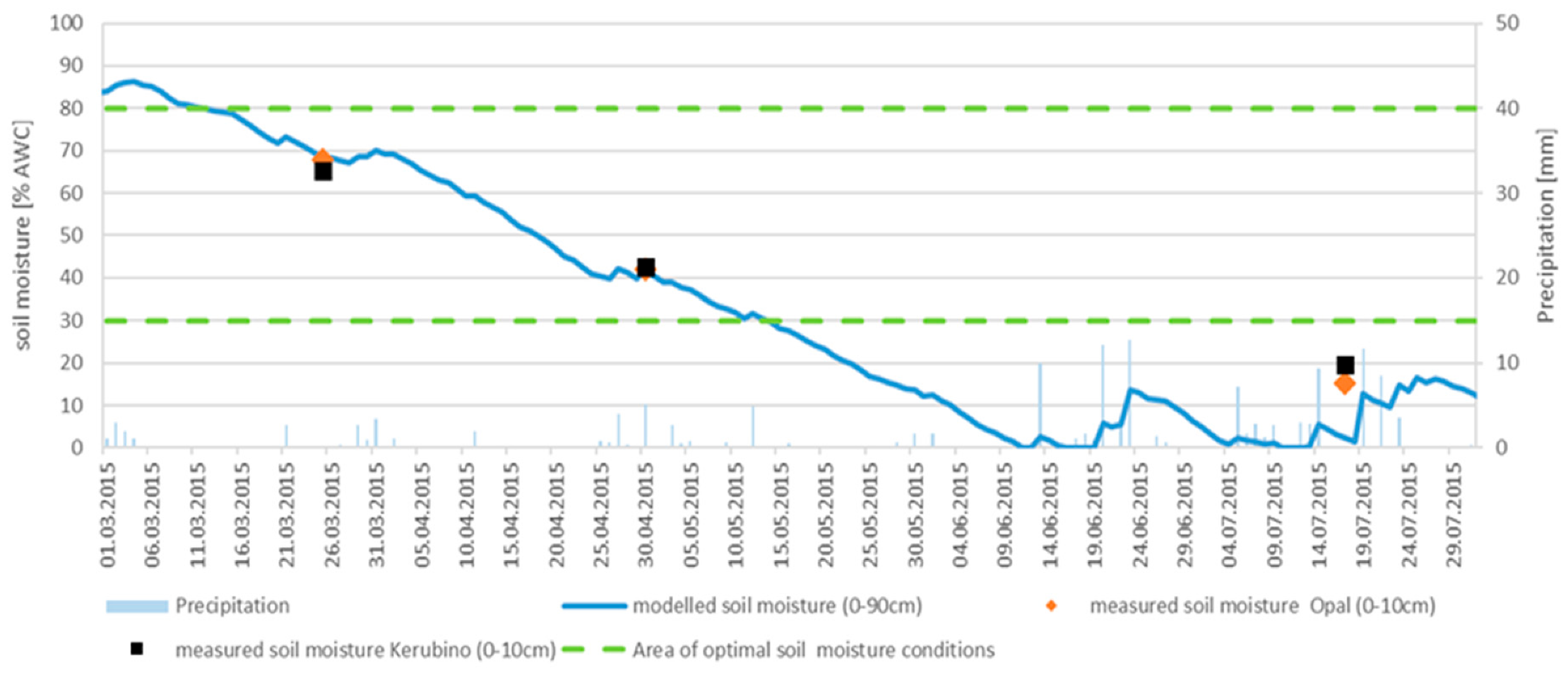

| 2015 | 2016 | 2017 | |
|---|---|---|---|
| average air temperature (March-July) | 13.6 °C | 14.3 °C | 14.0 °C |
| amount of precipitation (March–July) | 145 mm | 175 mm | 360 mm |
| winter wheat varieties | Opal & Kerubino | Opal & Kerubino | Edgar & Kerubino |
| plots | 2 unirrigated plots p. variety 2 irrigated plots p. variety | 2 unirrigated plots p. variety 6 irrigated plots p. variety | 3 unirrigated plots p. variety 3 irrigated plots p. variety |
| dates of irrigation | not available | 04.05., 10.05., 17.05., 23.05., 31.05., 8.06., 23.06., 30.06. | 26.04., 12.05., 18.05., 23.05., 29.05., 01.06., 20.06. |
| date of sowing | not available | 12.10.2015 | 23.09.2016 |
| date of harvest | not available | 20.07.2016 | 31.07.2017 |
| dates of measured soil moisture | 29.03., 30.04., 29.05., 11.06., 17.07. | 08.03., 15.04., 28.04., 10.05., 24.05., 07.06., 21.06., 04.07. | 28.03., 11.04., 03.05., 17.05., 24.05., 31.05., 28.06., 12.07. |
| biometric parameters (number of measurements for each plot) | plant height (6), leaf area index (5), degree of coverage (5), Growth stages (4) | plant height (8), leaf area index (8), degree of coverage (8), chlorophyll SPAD value (7), Growth stages (7) | plant height (9), leaf area index (5), degree of coverage (9), chlorophyll SPAD value (7), Growth stages (7) |
| Macro Growth Stages of BBCH—Scale | Description of Stage |
|---|---|
| 0 | Germination |
| 10 | Seeding growth |
| 20 | Tillering |
| 30 | Stem elongation |
| 40 | Booting |
| 50 | Ear emergence |
| 60 | Flowering |
| 70 | Milk developement |
| 80 | Dough developement |
| 90 | Ripening |
| Jan. | Feb. | Mar. | Apr. | May | Jun. | Jul. | Aug. | Sep. | Oct. | Nov. | Dec. | Year | ||
|---|---|---|---|---|---|---|---|---|---|---|---|---|---|---|
| amount of precipiation [mm] | 1961–1990 | 44.0 | 37.7 | 38.2 | 44.1 | 56.3 | 69.5 | 52.4 | 60.3 | 45.5 | 35.5 | 47.3 | 55.0 | 585.7 |
| 2015 | 36.9 | 4.3 | 17.0 | 14.4 | 14.3 | 43.4 | 55.5 | 63.4 | 24.3 | 57.7 | 49.8 | 14.8 | 395.8 | |
| 2016 | 17.1 | 24.0 | 22.3 | 27.3 | 23.5 | 56.6 | 46.2 | 27.9 | 10.5 | 32.9 | 18.3 | 35.8 | 342.4 | |
| 2017 | 14.6 | 20.2 | 36.9 | 18.0 | 33.0 | 160.4 | 112.2 | 50.5 | 38.7 | 72.8 | 47.2 | 21.7 | 626.2 | |
| average air temperature [°C] | 1961–1990 | −0.8 | 0.2 | 3.6 | 8.1 | 13.2 | 16.6 | 17.9 | 17.5 | 13.8 | 9.4 | 4.2 | 0.7 | 8.7 |
| 2015 | 3.7 | 2.6 | 6.8 | 10.1 | 14.2 | 17.7 | 17.7 | 22.1 | 14.3 | 8.6 | 7.9 | 7.1 | 11.1 | |
| 2016 | −0.1 | 3.9 | 4.9 | 9.2 | 16.3 | 20.4 | 20.8 | 19.1 | 18.8 | 9.0 | 3.9 | 3.0 | 10.8 | |
| 2017 | −1.0 | 2.5 | 7.8 | 8.7 | 15.7 | 18.7 | 19.2 | 19.5 | 14.4 | 11.9 | 6.1 | 3.7 | 10.6 | |
| heat sum [°C] | 1961–1990 | 1938.8 | ||||||||||||
| 2015 | 2228.4 | |||||||||||||
| 2016 | 2370.1 | |||||||||||||
| 2017 | 2250.0 | |||||||||||||
| 2015 | 2016 | 2017 | ||||||
|---|---|---|---|---|---|---|---|---|
| Period | Length | GS | Period | Length | GS | Period | Length | GS |
| 05 March–20 March | 16 | 08 March–21 March | 14 | 30 March–11 April | 17 | 30 | ||
| 12 April–25 April | 14 | 31 March–12 April | 13 | 24 April–03 May | 14 | 33 | ||
| 13 May–27 May | 15 | 30–39 | 29 April–11 May | 13 | 30–39 | |||
| 02 June–12 June | 11 | 50–59/60 | 13 May–22 May | 10 | 30–39 | |||
| 24 July–09 August | 17 | 92 | 18 June–03 July | 16 | 50–59/60 | |||
| 15 July–26 July | 12 | 87 | ||||||
| 2015 | 2016 | 2017 | ||||||||||||
|---|---|---|---|---|---|---|---|---|---|---|---|---|---|---|
| Opal Irrigated | Opal | Kerubino Irrigated | Kerubino | Opal Irrigated | Opal | Kerubino Irrigated | Kerubino | Edgar Irrigated | Edgar | Kerubino Irrigated | Kerubino | |||
| 25.03. | 20 | 20 | 20 | 20 | 28.03. | 25 | 25 | 25 | 25 | |||||
| 15.04. | 30 | 30 | 30 | 30 | 11.04. | 30 | 30 | 30 | 30 | |||||
| 28.04. | 31 | 31 | 31 | 31 | ||||||||||
| 03.05. | 33 | 33 | 33 | 33 | ||||||||||
| 10.05. | 33 | 33 | 33 | 33 | 17.05. | 33 | 33 | 33 | 33 | |||||
| 24.05. | 51 | 53 | 56 | 56 | 24.05. | 50 | 51 | 56 | 57 | |||||
| 29.05. | 60 | 50 | 60 | 50 | 31.05. | 61 | 61 | 62 | 62 | |||||
| 11.06. | 60 | 60 | 60 | 60 | 07.06. | 62 | 62 | 62 | 62 | 14.06. | 74 | 74 | 75 | 74 |
| 21.06. | 80 | 80 | 80 | 80 | 28.06. | 84 | 84 | 84 | 84 | |||||
| 04.07. | 87 | 85 | 87 | 85 | 12.07. | 87 | 90 | 89 | 91 | |||||
| 17.07. | 92 | 92 | 92 | 92 | ||||||||||
| Grain Yield at 86% Dry Matter in t/ha | Straw Yield at 86% Dry Matter in t/ha | |||||||
|---|---|---|---|---|---|---|---|---|
| Opal/Edgar | Opal/Edgar Irrigated | Kerubino | Kerubino Irrigated | Opal/Edgar | Opal/Edgar Irrigated | Kerubino | Kerubino Irrigated | |
| 2015 | 5.1 | 5.6 | 5.3 | 6.7 | 3.4 | 3.5 | 3. | 3.9 |
| increase in earnings (%) | 9 | 25 | 6 | 25 | ||||
| 2016 | 4.7 | 5.6 | 4.8 | 6.2 | 2.1 | 2.7 | 2.1 | 2.9 |
| increase in earnings (%) | 19 | 31 | 28 | 38 | ||||
| 2017 | 6.1 | 7.1 | 6.4 | 7.2 | 3.9 | 5.0 | 3.9 | 5.5 |
| increase in earnings (%) | 17 | 14 | 29 | 40 | ||||
| Yield (t/ha) of the Winter Wheat Varieties (Average Grain Yield of the Trial Plots) | ||||||
| Opal/Edgar | Kerubino | |||||
| 2015 | 2016 | 2017 | 2015 | 2016 | 2017 | |
| Yield without irrigation | 5.1 | 4.7 | 6.1 | 5.3 | 4.8 | 6.4 |
| Yield with irrigation | 5.6 | 5.6 | 7.1 | 6.7 | 6.2 | 7.2 |
| Difference | 0.5 | 0.9 | 1.0 | 1.4 | 1.4 | 0.8 |
| Proceedsin(€/t) from the Winter Wheat Varieties (https://markt.agrarheute.com/marktfruechte-1/weizen-6 abgerufen on 28 October 2020 at 7:00 p.m.) | ||||||
| Opal/Edgar | Kerubino | |||||
| 2015 | 2016 | 2017 | 2015 | 2016 | 2017 | |
| Proceeds (unirrigated) | 93.9 | 86.3.0 | 110.9 | 98.6 | 88.4 | 118.0 |
| Proceeds (irrigated) | 101.9 | 102.8 | 129.3 | 123.8 | 115.6 | 134.4 |
| Difference | 8.0 | 16.5 | 18.4 | 25.2 | 27.2 | 16.4 |
| Amount (mm) and Costs of Irrigation (€) | ||||||
| Opal/Edgar | Kerubino | |||||
| 2015 | 2016 | 2017 | 2015 | 2016 | 2017 | |
| Amount of irrigation (mm) | - | 80 | 70 | - | 80 | 70 |
| Costs of irrigation (×2.80) in (€) [27] (p. 158) | - | 224 | 196 | - | 224 | 196 |
| Annual process costs of the irrigation machine with nozzle trolley (pipe diameter 90 × 6.7 mm) [27] (p. 157/158) | - | 242 | 242 | - | 242 | 242 |
| Proceeds (€/t) from the Winter Wheat Varieties | ||||||
| Opal/Edgar | Kerubino | |||||
| 2015 | 2016 | 2017 | 2015 | 2016 | 2017 | |
| Proceeds (unirrigated) | 93.9 | 86.3 | 110.9 | 98.6 | 88.4 | 118.0 |
| Proceeds (irrigated minus costs of irrigation) | - | 56.2 | 85.5 | - | 69.0 | 90.6 |
| Difference | - | −30.1 | −25.4 | - | −19.4 | −27.4 |
| Date, BBCH-Stade and Winter Wheat Variety | 15.04.2016 BBCH 30 | 28.04.2016 BBCH 31 | 10.05.2016 BBCH 33 | 24.05.2016 BBCH 51–56 | |||||
| Biometric Parameters | Opal | Kerubino | Opal | Kerubino | Opal | Kerubino | Opal | Kerubino | |
| plant height | 0.877 | 0.660 | 0.212 | 0.144 | 0.148 | 0.860 | 0.377 | 0.562 | |
| LAI | 0.525 | 0.473 | 0.129 | 0.057 | 0.440 | 0.979 | 0.058 | 0.065 | |
| chlorophyll value | 0.262 | 0.142 | 0.087 | 0.007 | 0.739 | 0.756 | 0.867 | 0.021 | |
| degree of coverage | 0.951 | 0.194 | 0.173 | 0.202 | 0.650 | 0.128 | 0.045 | 0.119 | |
| Date, BBCH-Stade and Winter Wheat Variety | 07.06.2016 BBCH 62 | 21.06.2016 BBCH 80 | 04.07.2016 BBCH 85–87 | ||||||
| Biometric Parameters | Opal | Kerubino | Opal | Kerubino | Opal | Kerubino | |||
| plant height | 0.085 | 0.673 | 0.033 | 0.480 | 0.005 | 0.123 | |||
| LAI | 0.483 | 0.479 | 0.799 | 0.954 | 0.268 | 0.159 | |||
| chlorophyll value | 0.032 | 0.790 | 0.675 | 0.748 | 0.310 | 0.163 | |||
| degree of coverage | 0.049 | 0.565 | 0.407 | 0.549 | 0.219 | 0.175 | |||
Publisher’s Note: MDPI stays neutral with regard to jurisdictional claims in published maps and institutional affiliations. |
© 2021 by the authors. Licensee MDPI, Basel, Switzerland. This article is an open access article distributed under the terms and conditions of the Creative Commons Attribution (CC BY) license (https://creativecommons.org/licenses/by/4.0/).
Share and Cite
Künzel, A.; Münzel, S.; Böttcher, F.; Spengler, D. Analysis of Weather-Related Growth Differences in Winter Wheat in a Three-Year Field Trial in North-East Germany. Agronomy 2021, 11, 1854. https://doi.org/10.3390/agronomy11091854
Künzel A, Münzel S, Böttcher F, Spengler D. Analysis of Weather-Related Growth Differences in Winter Wheat in a Three-Year Field Trial in North-East Germany. Agronomy. 2021; 11(9):1854. https://doi.org/10.3390/agronomy11091854
Chicago/Turabian StyleKünzel, Alice, Sandra Münzel, Falk Böttcher, and Daniel Spengler. 2021. "Analysis of Weather-Related Growth Differences in Winter Wheat in a Three-Year Field Trial in North-East Germany" Agronomy 11, no. 9: 1854. https://doi.org/10.3390/agronomy11091854
APA StyleKünzel, A., Münzel, S., Böttcher, F., & Spengler, D. (2021). Analysis of Weather-Related Growth Differences in Winter Wheat in a Three-Year Field Trial in North-East Germany. Agronomy, 11(9), 1854. https://doi.org/10.3390/agronomy11091854






